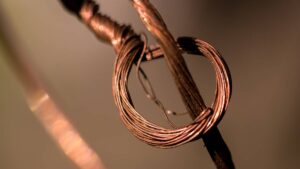EXPLAINER: So you think you can drill – How to read nickel and copper exploration results

Pic: Tunart/E+ via Getty Images.
- Exploration for new nickel and copper deposits is increasing in response to burgeoning demand from the EV and renewable energy sector
- How do punters separate a good copper/nickel drill hit from bad? We ask veteran geologist Jon Hronsky
So You Think You Can Drill: a series where we ask the experts what to look for in ASX exploration results.
This chart from the International Energy Agency shows how much more metal electric vehicles need compared to an internal combustion engine car.

This chart shows how commodity intensive renewable energy is compared with power generated by fossil fuels.

In the most bullish ‘sustainable development scenario’ mapped by the IEA, mineral demand from EVs increases 30 times over on 2020 levels by 2040.
No wonder so many companies wants to drill for battery metals right now.
Base metals nickel and copper have long had ‘old world’ applications in stainless steel, wiring and infrastructure, but the momentum behind the green energy thematic has helped nickel trading at levels not seen since its 2007 boom. Copper has spent almost 12 months near all time highs.
Nickel, which sagged to US$7600/t at its nadir in 2016 is now fetching almost US$35,000/t, 107% higher in just 12 months. Copper is trading at around US$10,400/t, just shy of all time records of a year ago, but global investment bank Goldman Sachs sees it hitting US$12,000/t by early next year and US$15,000/t in the long run as demand dramatically outpaces supply.
The boom in battery metals is ripe for the picking. Current copper production and expected new supply will only over 80% of demand by 2030, the IEA says.
Market conditions this good will boost the profits and payouts of existing battery metals miners and provide the capital to drill for new discoveries.
But it is also a fertile environment for those with a command of the dark arts of mining PR to sell a story that may be too good to be true when those drilling assays come to market.
How do you know the results that sent your stock up 20% yesterday are meaningful in the long run?
We spoke to one of Australia’s preeminent experts in nickel and copper exploration to tell us what to look out for when you want to know if your investment is onto a winner.
NICKEL
A good nickel hit
Nickel is usually found in two main ore types – sulphide or laterite.
Sulphides (class 1) are much cheaper and easier to turn into battery grade nickel sulphate than nickel laterites and fetch a higher price.
But supply of nickel sulphides is also declining because of a lack of new discoveries.
Looking for a good hit of nickel sulphide?
Jon Hronsky was one of Western Mining Corporation’s top geologists back in the day and is credited with leading the team that found the West Musgrave nickel and copper deposit on the WA-SA border in the late 1990s.
West Musgrave is one of only a handful of large scale nickel sulphide discoveries in WA in the past three decades. A decision on its $1.1 billion development by current owner OZ Minerals (ASX:OZL) is expected this year.
Now the boss at consultancy Western Mining Services, Hronsky knows just about every major nickel field in the world like the back of his hand.
He says a good nickel sulphide hit will typically be something at least 2m wide with around 1.5-2% nickel or higher. But … Context. Is. Everything.
“It’s never just about the results, it’s always about the context the results get fitted into,” he said.
“I know everyone looks at the highlight results and in fact companies deliberately emphasise results out of context because you know, a lot of investors, particularly the sort of more naive investors, do have that sort of heuristic, rule of thumb that they just respond to the actual numbers in intersections.”
Take Sirius Resources’ announcement of the Nova nickel-copper mine for example. Out on its ass and with its bank account near bone dry, Sirius announced a strike on July 26, 2012 of 4m at 3.8% nickel and 1.42% copper right where its electromagnetic modelling told it to look about 190m underground.
But there were other important tidbits that suggested the now ~30,000tpa mine was the real deal.
A step out hole after the discovery intersected 15m of similar matrix to massive style sulphide mineralisation 55m up-dip from the discovery, pointing to a major, consistent ore body, with a new style of mineralisation in a largely unexplored mineral province.
“One of the first things to evaluate when you get a result is: is this some new discovery, some new area where that hole could be the first hole in a big orebody — like say the first hole into Nova — or is this a drill hole that’s only drilled a few metres away from known existing mineralisation?” Hronsky adds.
“If it was a small ore body before and you drill another hole and get another intersection a few metres away it’s still a small ore body.”
Disseminated to the massives
Sulphide nickel deposits like those found in WA’s Kambalda Dome are prized over other forms of nickel in the western world for a few reasons.
Firstly, they are relatively simple to process into a concentrate and cheap to produce in comparison to other kinds of nickel like shallow laterites.
Secondly, they can be easily converted into pure nickel briquettes accepted by the London Metals Exchange and nickel sulphate, the chemical used in nickel-rich lithium ion battery chemistries in Tesla EVs.
For that reason, these kinds of nickel deposits are the most important for investors wedded to the battery metal thematic to get their heads around.
The narrow veined high grade sulphide drill hits common to Kambalda, Kalgoorlie and elsewhere in WA generate the tastiest looking results.
“In terms of (a good hit for) nickel you could think of sort of higher grade massive sulphide nickel where we might have a few meters — and this is what a lot of Kambalda stuff would be — so maybe between 2-10 meters of intersection, and the grade we’d be looking for usually over that interval we’d want certainly more than 1% nickel, ideally more than 2% nickel, and sometimes it can be a bit higher than that,” Hronsky says.
“But you want intervals that are thicker than about two meters, and grades that are higher than about one and a half or 2% as sort of a minimum that’s in sulphide nickel.”
But large scale disseminated sulphide intersections can be equally valuable, and provide a platform for large, long life production.
The most obvious example in Australia is BHP’s (ASX:BHP) Mt Keith mine, which along with the high grade Leinster underground project makes up its northern operations around 400km north of Kalgoorlie-Boulder.
Developed by WMC in the 1990s, Mt Keith feeds a ~40Mtpa concentrator with a resource grade averaging around 0.6% nickel.
“You can also have intersections of still sulphide, but disseminated, nickel, where you might have several 10s of meters, 50 to 100 meters,” Hronsky said.
“And in those sort of intersections there will be lower grades between 0.4-0.6% nickel, that might be significant.
“So obviously, if it’s narrower it has to be higher grade, if it’s lower grade, it has to be wider and thicker.
“The other point is that if it’s a low grade intersection but it’s 500m deep, it’s not going to be very relevant because the low grade will only be relevant if you can mine it in an open pit.
“Whereas high grade, if it’s five meters at 5% nickel or 10% nickel, that’s something you could mine in a deep underground mine so it doesn’t matter whether it’s deep. So (depth) is another important filter.”
Beware the lateritic enrichment
The biggest red flag though is companies passing of shallow, lateritic nickel enrichment as a hit of significance.
We haven’t seen it in a long time, but in a boom these practices can reemerge quickly.
“I think in nickel, the biggest one to be aware of is people passing off lateritic enrichment as significant mineralisation,” Hronsky said.
“It’s got nothing to do with mineralisation.
“What we have to be very careful about is and we see this every nickel boom, when you know the nickel price is up and everyone dusts out these old nickel laterite processes.”
While serious nickel discoveries are often associated with ultramafic rocks, like Nova or Chalice’s Julimar nickel-copper-PGE find, not all ultramafics have economic nickel in them.
“Ultramafic rocks have high background levels of nickel, like a few thousand ppm,” Hronsky said. “It’s not extractable and it’s not economic, but in the weathered zone, these can often get concentrated.
“So if you just drill nickel in the laterite and say we drilled 20 meters at 1% nickel, wow. Well, no that’s kind of meaningless.”
What about laterite deposits?
It is true that some nickel deposits mined today are lateritic.
In fact, because of the scarcity and lack of investment in new nickel sulphide discoveries most new nickel production is likely to come from large, shallow lateritic orebodies in Indonesia and the Pacific.
But their abundance and superficial nature mean it’s unlikely an explorer will stumble over a major new deposits at this stage in mining history.
“Laterite deposits, by definition, they’re near the surface so kind of everyone knows about them,” Hronsky said.
“In places like Indonesia and the Philippines there’s quite a bit of sort of … rape and pillage mining of these high grade laterite deposits that they just put on a ship and they take to China but once again, these are deposits that were known about for 50 years.
“And it’s just the sort of the economics change and the technology in China and the end-use technology changed such that all of a sudden they could be exploited.
“But the chances of someone finding a new big laterite deposit that’s never been known is pretty low because by definition they need to be exposed at the surface.”
Booming nickel prices of around US$35,000/t (let’s forget that brief moment last month a weird short squeeze sent them to US$100,000/t for a minute) have brought nickel laterite projects back into the frame.
But their capex, operating costs and development timelines can make them extremely difficult to develop, according to Hronsky.
“If you can find someone who’ll spend the first $2 billion of capital and write that off, then you’ve got about a 50% chance of having a mine that will actually work,” Hronsky said.
“Half of them work after that point, half of them don’t. But they have a pretty poor track record. They’re complex, they’re difficult, they’re capitally intensive.
“The investors in Andrew Forrest’s Anaconda Nickel project (Murrin Murrin) lost everything. And what do we have at the moment? We’ve got you know Ravensthorpe, BHP put $2 billion into it. First Quantum bought it for about $300 million. At current prices they’re probably doing okay.”
In general Hronsky says investors should be sceptical of projects that have been passed from company to company and been heavily promoted in each new mineral cycle.
“There’s one in the Riddle complex (in the USA) that’s sort of nickel-PGEs-copper,” he said.
“It’s probably the size of this room, but about every 10 or 15 years a new company drills it and gets a bit of a run on their share price.
“So those are the things to be aware of. Context is important and a drill hole that’s drilled at a prospect that people have been exploring for a long time and it’s never been that significant, is nowhere near as important as a new drill hole that’s in a new project somewhere out in the bush like say the original Nova discovery or DeGrussa or something like that.”
COPPER
A tale of two (or so) coppers
In the case of copper, which is regularly found in deposits with other metals like nickel, gold, silver and zinc, there are a few different styles of mineralisation, each with their own unique characteristics.
The main two are volcanogenic massive sulphide deposits (VMS) and porphyries.
The former is typically narrow and high grade, with the potential for small scale underground mining.
The latter is typically lower in grade, often around 0.4% copper, but massive in its accumulations of copper ore, with mining undertaken in large open pits or via bulk underground mining methods like block caving.
Alongside those you also have iron-oxide-copper-gold (IOCG) deposits like BHP’s Olympic Dam and Evolution Mining’s (ASX:EVN) Ernest Henry, large deposits which are moneymakers at grades of around 1%, and Zambian-style sediment hosted deposits which, like VMS orebodies, are higher in grade at 2% or above.
Those are normally found in the Central African copper belt and include mines like Glencore’s Katanga but are also found in Australia in places like Cyprium’s (ASX:CYM) Nifty copper mine in the Pilbara.
For Hronsky, a 3 to +20m metres at 2% copper or above is a good hit in a VMS ore body, and their polymetallic nature can mean additional by products like zinc, nickel or gold will add value.
Unlike nickel, copper hits in the ‘weathering’ zone above a potential ore body is a good sign.
“If you see high levels of copper in the weathering zone, that means it’s come from some primary copper ore body somewhere,” Hronsky said.
“Now, the oxidised copper actually can generally be treated, so it’s not like the nickel laterite which is very complex and hard and expensive to treat.
“Copper as a metal is not worth as much as nickel but once again, you could look at whether you’ve got narrow high grade mineralisation, where you’d be looking at a few meters to a few 10s of meters, then you want the copper grade to be something like the Nifty deposit would be an example, you’d want the grade to be over 2% copper.
Broader disseminated zones could look decent if you find intersections at 50-100m of thickness with a copper grade greater than about 0.5% copper, and gold values often help out. Porphyries can be economic at even lower grades.
“Whereas in the porphyry deposits, you typically won’t have high grade copper — there is a subset of porphyries like Stavely’s (ASX:SVY) Cayley Lode which has relatively high grade copper veins but they’re part of an overall porphyry system,” Hronsky said.
“They’re relatively unusual and typically with porphyries we’re looking at broad intersections of disseminated mineralisation of the order of 100m-plus and usually at least 0.4% copper.”
Where are the traps?
“Many porphyry deposits have have a ‘pipe like’ geometry, whereas VMS deposits, nickel sulphide deposits, [and] gold deposits have a ‘sheet like’ geometry,” Hronsky says.
“With sheet like geometry you drill through the sheet, and you get the intersection that’s more or less the true thickness of it.”
True thickness is the width of the vein/sheet etc at its narrowest point.
“But if you’re drilling out a [porphyry] pipe, drill holes tend to go down the pipe and get much much longer intersections of mineralisation.
“You imagine you’ve got a pipe and you drill down the centre of the pipe; you can stay in mineralisation for 500 meters. Does that mean that you found the world’s biggest ore body? No, it doesn’t. The thing might only be 10 or 20 meters wide.”
Hronsky recommends that investors look for what is missing in a company results. As we mentioned earlier, context is everything.
“If results are released showing pictures of drill core, but they don’t show plans, cross sections and long sections that make it very easy to assess the context of that mineralisation, that’s probably telling you something,” he said.
Coming up in Part 2 of So You Think You Can Drill: How to know if your lithium stock may be onto a winner.
Related Topics

UNLOCK INSIGHTS
Discover the untold stories of emerging ASX stocks.
Daily news and expert analysis, it's free to subscribe.
By proceeding, you confirm you understand that we handle personal information in accordance with our Privacy Policy.








